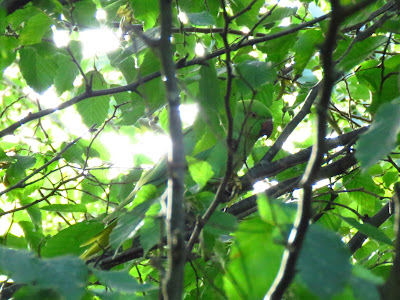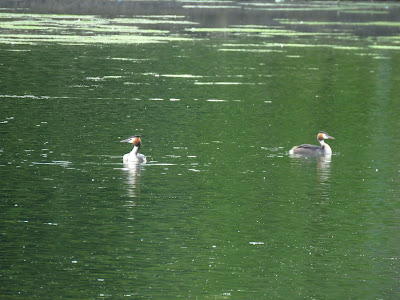A sunny, mild day, I decided to stop at Rockford fields on my way to East Park with the bat detector, hoping to find some bush-crickets. On my way there, I found two Willow Warblers, which were hunting insects by the cycle path. At some point one stopped to preen and bask in the sunshine.
Cricket recording conditions were optimal, and the chugging of the coneheads was loud when I turned on the bat detector. Now, only finding them remains. It didn't take long. The SE facing scrubby edge with long grass and bramble gave ideal watching conditions, as male Roesel's and Long-winged coneheads called and females basked.
View of Rockford fields LNR.
This is the corner of the field.
A pair of Long-winged Coneheads.
Four Long-winged Coneheads are visible in the photo.
Male Roesel's bush-cricket calling.
Araneus quadratus.
A group of basking Lesser Marsh Grasshoppers.
Female Roesel's basking.
Female Roesel's basking, note the lowered rear leg facing the sun.
Araneus quadratus with greenbottle prey.
Nursery Web spider.
In the south area of the field, there is a large tree trunk. I carefully moved around to the sunny side of it as it looked ideal for basking. There were at least 4 Roesel's, several coneheads, Lesser Marsh Grasshoppers are a large Araneus quadradus which ended up capturing one of the grasshoppers.
A rare face on view of one female Roesel's, note the tympanic organs on the tibia of the forelimbs.
East Park
As soon as I get to East Park I hear a persistent Ring-necked Parakeet, calling from deep in some bushes.
Ring-necked Parakeet.
The Great Crested Grebes haven't been successful this year.
Six terrapins were visible. Four on the zoo island fallen trunk.
One of the central island terrapins keeping a close eye on the Grey Heron.
This one just emerged from the water, covered on duckweed.
It was time to do an Odonata count. Migrant and Brown Hawkers were present along the lake, a Brown Hawker female was seen looking for oviposition sites, but it was chased away by a male Common Darter.
Male Migrant hawker.
Common Darter. At least 2 pairs in tandem and one ovipositing were seen.
In 2019, I saw my first Willow Emerald by the boardwalk (discovered by Richard Shillaker a couple of days earlier, the first of East Yorkshire), today, three years later, I saw a male in exactly the same spot, but it was the first of at least 8 individuals. There is now a thriving population at the park. I saw many males guarding trees and one pair in tandem.
Willow Emeralds in tandem.
Migrant Hawkers in tandem.
The now widespread Alder Leaf beetle.































4 comments:
Fascinating to discover that bush crickets hear with their front legs. I suppose the spacing gives them better sensitivity to the direction of the sound.
Hi Dr Gomez, love your work. I was wondering if I might use your spider illustrations from some of your other, older, posts in a project I'm doing? Properly linked and attributed, of course. The rough draft/outline of my project is here if you wish to see how your images will be applied.
Cheers,
Lynnie
https://l-turnbull.github.io/sp-ID-er-/
HI Lynnie, sorry I missed your comments, blogger doesn't notify me by email any more, oddly. You are more than welcome to use the images attributed and with the cc licence, in your project, such a fun project too!
Post a Comment